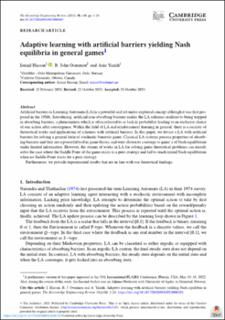| dc.contributor.author | Oommen, John B. | |
| dc.contributor.author | Yazidi, Anis | |
| dc.date.accessioned | 2023-12-08T07:50:41Z | |
| dc.date.available | 2023-12-08T07:50:41Z | |
| dc.date.created | 2023-11-29T10:56:38Z | |
| dc.date.issued | 2023 | |
| dc.identifier.citation | Knowledge engineering review (Print). 2023, 38 . | en_US |
| dc.identifier.issn | 0269-8889 | |
| dc.identifier.uri | https://hdl.handle.net/11250/3106539 | |
| dc.description.abstract | Artificial barriers in Learning Automata (LA) is a powerful and yet under-explored concept although it was first proposed in the 1980s. Introducing artificial non-absorbing barriers makes the LA schemes resilient to being trapped in absorbing barriers, a phenomenon which is often referred to as lock in probability leading to an exclusive choice of one action after convergence. Within the field of LA and reinforcement learning in general, there is a sacristy of theoretical works and applications of schemes with artificial barriers. In this paper, we devise a LA with artificial barriers for solving a general form of stochastic bimatrix game. Classical LA systems possess properties of absorbing barriers and they are a powerful tool in game theory and were shown to converge to game’s of Nash equilibrium under limited information. However, the stream of works in LA for solving game theoretical problems can merely solve the case where the Saddle Point of the game exists in a pure strategy and fail to reach mixed Nash equilibrium when no Saddle Point exists for a pure strategy. Furthermore, we provide experimental results that are in line with our theoretical findings. | en_US |
| dc.language.iso | eng | en_US |
| dc.rights | Navngivelse 4.0 Internasjonal | * |
| dc.rights.uri | http://creativecommons.org/licenses/by/4.0/deed.no | * |
| dc.title | Adaptive learning with artificial barriers yielding Nash equilibria in general games | en_US |
| dc.type | Peer reviewed | en_US |
| dc.type | Journal article | en_US |
| dc.description.version | publishedVersion | en_US |
| cristin.ispublished | true | |
| cristin.fulltext | original | |
| cristin.qualitycode | 2 | |
| dc.identifier.doi | 10.1017/S0269888923000103 | |
| dc.identifier.cristin | 2204898 | |
| dc.source.journal | Knowledge engineering review (Print) | en_US |
| dc.source.volume | 38 | en_US |
| dc.source.pagenumber | 24 | en_US |

